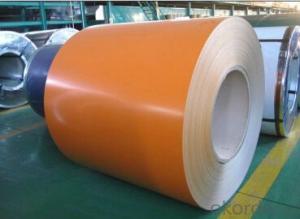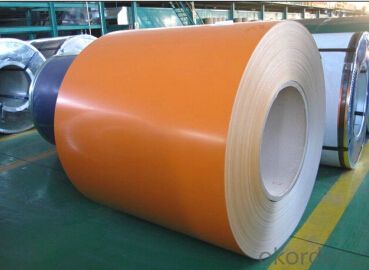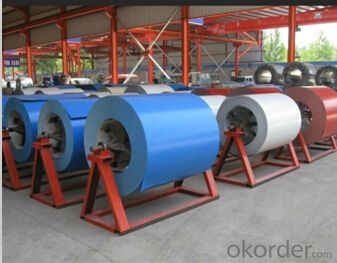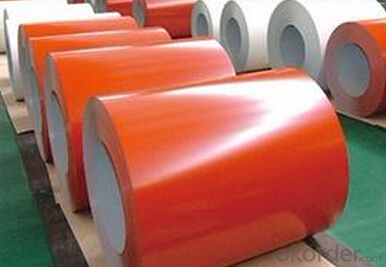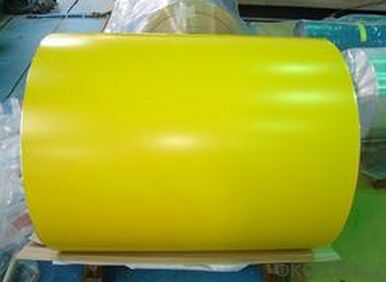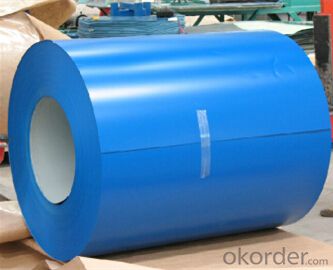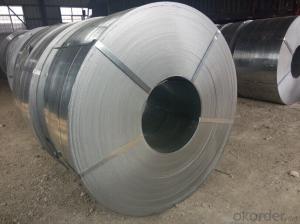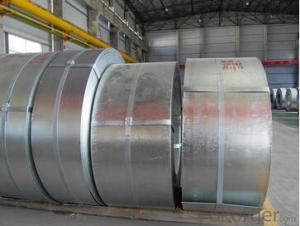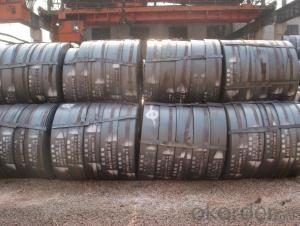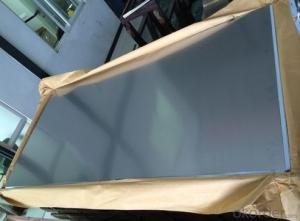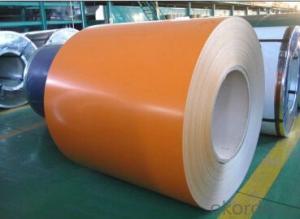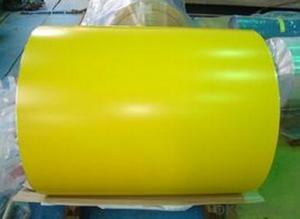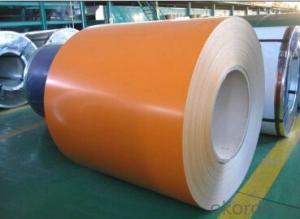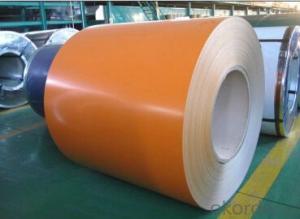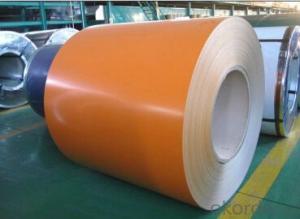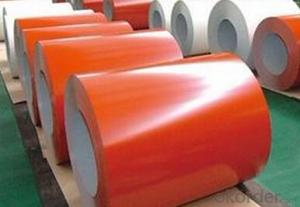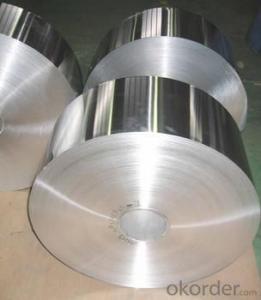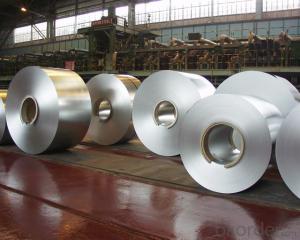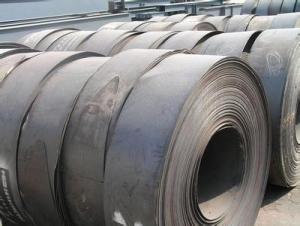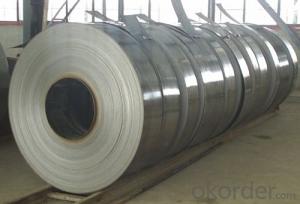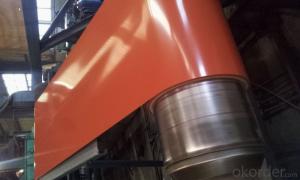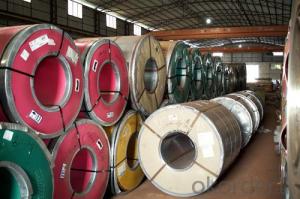Chinese Best Prepainted Galvanized steel Coil ASTM 615
- Loading Port:
- Tianjin
- Payment Terms:
- TT OR LC
- Min Order Qty:
- 26 m.t.
- Supply Capability:
- 22222 m.t./month
OKorder Service Pledge
OKorder Financial Service
You Might Also Like
1.Structure of Prepainted Galvanized steel Coil :
With Gi as base metal,after pretreatmet (degrease and chemical treatment) and liquid dope with several Layers of color,then after firing and cooling,finally the plate steel is called pre-painted galvanized steel ( PPGI) .Pre-painted galvanized steel is good capable of decoration ,molding,corrosion resistance
2.Main Features of Prepainted Galvanized steel Coil:
• Excellent process capability
• Smooth and flat surface
• Workability, durability
• Excellent heat resistance performance
• High strength
• Good formability
• Good visual effect
3.Prepainted Galvanized steel Coil Images
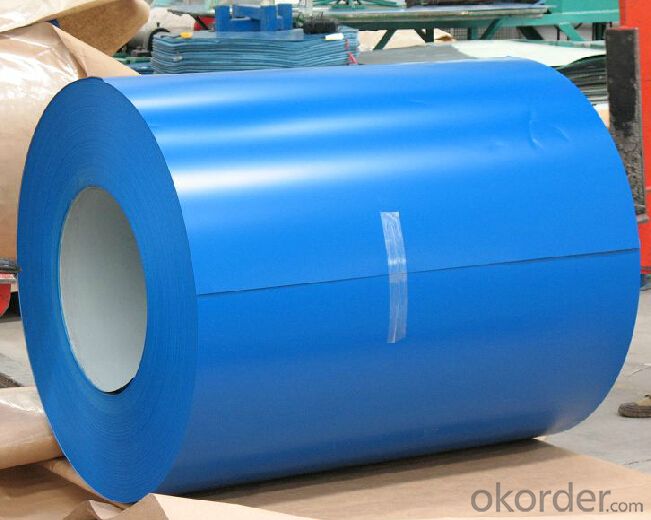
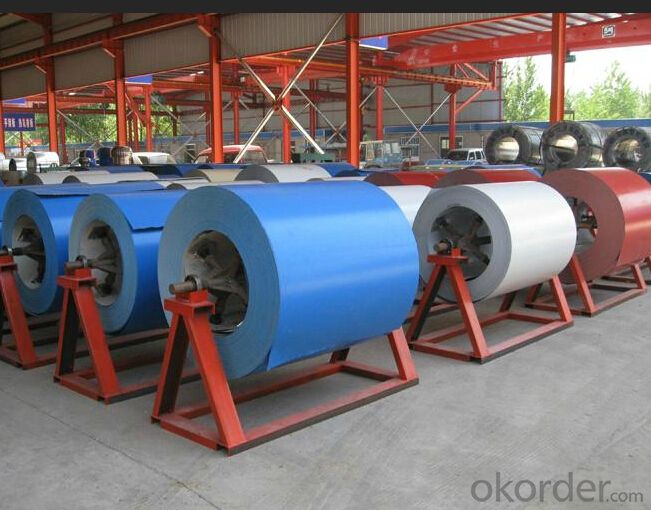
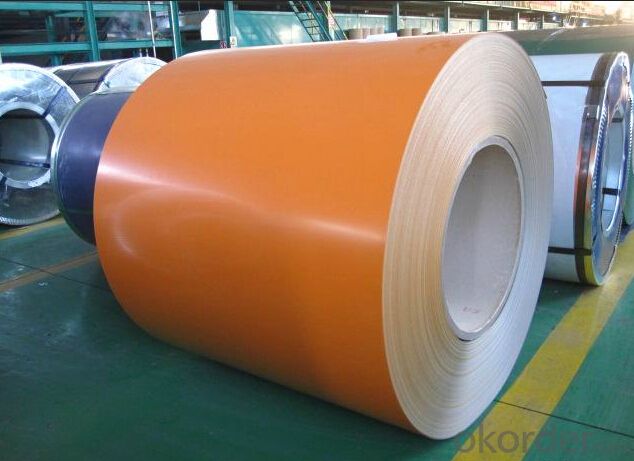
4.Prepainted Galvanized steel Coil Specification
Standard:ASTM, GB,JIS,JIS G3302 ASTM 755 EN10169
Grade: DX51D CGCC CS
Thickness: 0.13mm~3.0mm,
Width: 1250,600-1250mm
Coil weight:3-12 MT
Coil ID:508/610mm
Chemical composition:
C | Si | Mn | Cr | Ni | P | S |
0.150 | 0.476 | 11.231 | 12.50 | 0.900 | 0.039 | 0.010
|
5.FAQ of Prepainted Galvanized steel Coi
We have organized several common questions for our clients,may help you sincerely:
1.How do you control your quality
We have established the international advanced quality management system,every link from raw material to final product we have strict quality test;We resolutely put an end to unqualified products flowing into the market. At the same time, we will provide necessary follow-up service assurance.
2.how long we will receive the goods ?
After receiving your deposit or workable lc ,our normal shipment date is 15-20days,and it takes around 28 days to reach your port of destination. But is up to different destination
3. what is your moq
Normally our moq is 25per size ,but it is up to different size
- Q: What are the factors to consider when selecting steel strips for a specific application?
- When selecting steel strips for a specific application, there are several factors that need to be considered in order to ensure optimal performance and durability. 1. Material Composition: The first factor to consider is the material composition of the steel strips. Different alloys and grades of steel offer varying levels of strength, corrosion resistance, and heat resistance. It is important to choose a material that is suitable for the specific application and can withstand the intended environmental conditions. 2. Thickness and Width: The thickness and width of the steel strips should be selected based on the desired strength and stability required for the application. Thicker strips generally offer higher strength, while wider strips provide increased stability and load-bearing capacity. 3. Surface Finish: The surface finish of the steel strips is crucial, as it affects their ability to withstand wear, corrosion, and other forms of damage. Different finishes, such as hot-rolled, cold-rolled, or galvanized, offer varying levels of protection and aesthetic appeal. The appropriate surface finish should be selected based on the specific application requirements. 4. Tensile Strength and Yield Strength: Tensile strength refers to the maximum amount of stress a material can withstand before it breaks, while yield strength is the stress level at which permanent deformation occurs. These mechanical properties are critical for determining the suitability of steel strips in applications that involve high loads or impacts. The desired tensile and yield strength should be determined based on the specific application requirements. 5. Ductility and Toughness: Ductility and toughness are important considerations when selecting steel strips for applications that involve bending, forming, or impact resistance. Ductility refers to the ability of a material to stretch without breaking, while toughness is its ability to absorb energy before fracturing. Both properties are crucial for applications that require flexibility and resistance to cracking or fracture. 6. Cost and Availability: Cost and availability are practical factors that need to be considered when selecting steel strips. It is important to evaluate the overall cost of the material, including procurement, transportation, and processing. Additionally, the availability of the specific steel strips required for the application should be considered to ensure timely delivery and avoid production delays. In conclusion, selecting steel strips for a specific application requires careful consideration of various factors, including material composition, thickness and width, surface finish, tensile and yield strength, ductility and toughness, as well as cost and availability. By evaluating these factors in relation to the specific application requirements, one can make an informed decision and choose the most suitable steel strips for optimal performance and durability.
- Q: What are the different types of stamping or forming processes for steel strips?
- Steel strips can be manipulated into different shapes and sizes using various stamping or forming processes. These processes are employed to achieve the desired end product. Some commonly used stamping or forming processes for steel strips are as follows: 1. Blanking: This involves cutting the steel strip into a specific shape or pattern using a die. Blanking is typically used for creating smaller parts or components. 2. Bending: By deforming the steel strip, a desired angle or curve can be achieved. This can be done using a press brake or other bending machines. 3. Deep drawing: This process is used to create complex shapes or forms from a flat steel strip. The strip is placed over a die and pressed into the die cavity to create the desired shape. 4. Roll forming: A continuous process where a steel strip passes through a series of rollers to gradually shape it into a specific profile. This method is commonly employed for creating long, continuous sections like metal roofing or building panels. 5. Embossing: This process involves creating raised or recessed patterns on the surface of a steel strip. A die or roller with the desired pattern is utilized for this purpose. 6. Coining: By compressing a steel strip between two dies, a specific shape or pattern can be created. This method is often utilized to add intricate designs or details to the surface of the strip. Each of these stamping or forming processes offers distinct advantages and is suitable for different applications. The choice of process depends on factors such as the desired end product, the complexity of the shape, and the production requirements.
- Q: What are the factors that affect the cost of steel strips?
- There are several factors that can affect the cost of steel strips. 1. Raw material costs: The price of steel strips is heavily influenced by the cost of the raw materials used to produce them, such as iron ore and other metallic elements. Fluctuations in the prices of these materials can have a significant impact on the overall cost of steel strips. 2. Manufacturing and processing costs: The cost of manufacturing and processing steel strips can vary depending on factors such as labor costs, energy costs, and production efficiency. These factors can affect the overall cost of production and, consequently, the price of steel strips. 3. Market demand and supply: The demand for steel strips in various industries can affect their price. When demand is high and supply is limited, prices tend to increase. Conversely, when demand is low or there is an oversupply, prices may decrease. 4. Transportation and logistics costs: The cost of transporting steel strips from the manufacturing facility to the end-user can impact their overall cost. Factors such as distance, mode of transportation, and fuel prices can all affect transportation costs and, subsequently, the price of steel strips. 5. Government regulations and tariffs: Government regulations and tariffs on steel imports or exports can influence the cost of steel strips. These regulations can impact the availability and cost of raw materials, as well as impose additional expenses on the manufacturing and distribution processes. 6. Currency exchange rates: Steel is often traded on international markets, and fluctuations in currency exchange rates can affect the cost of steel strips. Changes in exchange rates can increase or decrease the cost of importing or exporting steel, which can ultimately impact the price of steel strips. It is important to note that these factors can vary in their influence and significance depending on the specific context and market conditions.
- Q: How are steel strips used in the production of electrical motors?
- Steel strips are used in the production of electrical motors for various purposes, such as creating the core laminations of the stator and rotor. These strips are stacked and insulated to form the core, which helps to reduce energy losses and increase the efficiency of the motor. Additionally, steel strips are used to manufacture the magnetic poles and other components of the motor, providing the necessary magnetic properties for its operation.
- Q: How are steel strips used in the renewable energy industry?
- Steel strips are widely used in the renewable energy industry for various purposes. One of the primary applications is in the manufacturing of wind turbines. Steel strips are used to produce the tower structures that support the blades and the nacelle, which houses the generator and other components. These strips provide the necessary strength and stability required to withstand the forces exerted by the wind. Furthermore, steel strips are also used in the construction of solar power systems. They are commonly utilized in the manufacturing of solar panel frames and mounting structures. These strips provide a robust framework that supports the solar panels and ensures their stability and durability. In addition, steel strips are often used in the production of electric vehicle (EV) components. As the demand for EVs continues to rise, steel strips are utilized in the manufacturing of battery casings, chassis, and other structural components. The use of steel strips in EVs helps to enhance their strength, safety, and overall performance. Moreover, steel strips are also utilized in the construction of hydropower plants. They are commonly used to fabricate gates, turbines, and other components of the power generation system. Steel strips provide the necessary strength and corrosion resistance required to withstand the harsh and demanding conditions of these environments. Overall, steel strips play a crucial role in the renewable energy industry by providing the necessary strength, durability, and stability required for the efficient functioning of various renewable energy systems. Their versatility and reliability make them an essential component in the production of wind turbines, solar power systems, electric vehicles, and hydropower plants.
- Q: What is the difference between hot rolling and cold rolling of steel strips?
- The main difference between hot rolling and cold rolling of steel strips lies in the temperature at which the rolling process takes place. Hot rolling involves heating the steel to high temperatures, typically above its recrystallization temperature, and then passing it through a series of rollers to shape it into the desired form. This process makes the steel more malleable and allows for the production of larger and thicker steel strips. On the other hand, cold rolling occurs at room temperature or slightly below. The steel is passed through rollers, often multiple times, to reduce its thickness and improve its surface finish. Cold rolling results in a harder and stronger steel strip compared to hot rolling, as the cooling process during rolling causes the creation of strain hardening. This makes cold-rolled steel strips suitable for applications that require higher strength and precision, such as automotive parts and electrical appliances.
- Q: How are steel strips cut into specific lengths?
- Steel strips are cut into specific lengths using various methods and tools. One of the most common methods is using a shear, which is a machine specifically designed to cut through metal. The steel strip is placed in the shear, and the shear's blades are then activated to cut through the strip, resulting in the desired length. Another method is using a saw, such as a circular saw or a band saw. These saws are equipped with sharp, toothed blades that can easily cut through steel. The steel strip is secured in place, and the saw is then used to cut through the strip, creating the desired length. Some advanced methods involve using laser cutting or plasma cutting technology. Laser cutting uses a high-powered laser beam to melt or vaporize the steel along the desired cutting line, resulting in a precise and clean cut. Plasma cutting, on the other hand, uses a jet of ionized gas to heat and melt the steel, allowing it to be easily cut into specific lengths. Regardless of the method used, it is crucial to have accurate measurements and precise control over the cutting process to ensure the steel strips are cut into the desired lengths.
- Q: How do steel strips perform in terms of machinability?
- Steel strips generally have good machinability. They can be easily shaped, cut, drilled, and formed into various components without excessive wear on the tools. However, the machinability may vary depending on the specific grade and composition of the steel strip.
- Q: How do steel strips perform under high temperatures?
- Steel strips are generally highly effective when subjected to high temperatures. Steel is renowned for its high melting point, which can vary from 1370°C to 1520°C (2500°F to 2750°F), depending on the specific type of steel. Consequently, steel strips possess the ability to endure exceedingly high temperatures without melting or compromising their structural integrity. Moreover, steel strips exhibit commendable thermal stability when exposed to elevated temperatures. They possess a low coefficient of thermal expansion, resulting in minimal expansion and contraction in comparison to other materials. This characteristic serves to prevent the warping or deformation of the strips when confronted with high temperatures. Additionally, steel strips possess exceptional strength and hardness, even under elevated temperatures. Although the strength of steel diminishes slightly as temperatures rise, it remains significantly stronger than numerous other materials. This attribute renders steel strips suitable for applications where resistance to high temperatures and mechanical strength are vital, such as in furnaces, boilers, and heat exchangers. Nevertheless, it is crucial to acknowledge that prolonged exposure to extremely high temperatures can bring about alterations in the properties of steel strips. At exceedingly high temperatures, steel may experience oxidation or scaling, leading to a deterioration in surface quality or corrosion resistance. Furthermore, repeated cycles of heating and cooling can result in thermal fatigue, causing the steel to become more brittle over time. As a result, careful consideration of these factors is necessary, along with the selection of the appropriate steel grade and surface treatment, to ensure optimal performance in high temperature conditions.
- Q: How are steel strips processed for temperature resistance?
- Steel strips are processed for temperature resistance through a series of methods and treatments. One common technique is heat treatment, which involves subjecting the steel strips to controlled heating and cooling cycles. This process alters the microstructure of the steel, making it more resistant to thermal deformation and ensuring that it maintains its strength and integrity even at high temperatures. Another method used is alloying, where specific elements are added to the steel composition to enhance its resistance to temperature extremes. For instance, chromium and nickel are often added to create stainless steel, which has excellent resistance to both high and low temperatures. This alloying process modifies the chemical properties of the steel, making it more stable and less prone to oxidation or corrosion at different temperature ranges. Coating the steel strips is also a common approach to improving temperature resistance. This involves applying a protective layer, such as zinc or aluminum, which acts as a barrier against heat and prevents the steel from reaching critical temperatures. Coatings can also provide additional benefits like corrosion resistance and insulation. Furthermore, cold rolling is often employed to increase the strength and toughness of the steel strips. This process involves passing the steel through a series of rollers at room temperature, which not only enhances its mechanical properties but also improves its ability to withstand temperature fluctuations without losing its structural integrity. Overall, the processing of steel strips for temperature resistance involves a combination of heat treatment, alloying, coating, and cold rolling. These techniques ensure that the steel can withstand extreme temperatures, maintain its strength, and resist the detrimental effects of thermal expansion and contraction.
Send your message to us
Chinese Best Prepainted Galvanized steel Coil ASTM 615
- Loading Port:
- Tianjin
- Payment Terms:
- TT OR LC
- Min Order Qty:
- 26 m.t.
- Supply Capability:
- 22222 m.t./month
OKorder Service Pledge
OKorder Financial Service
Similar products
Hot products
Hot Searches
Related keywords
